


Cerro Gordo County Iowa
Part of the IaGenWeb Project
|
715 6th Street S.W., Mason City Cerro Gordo County, Iowa
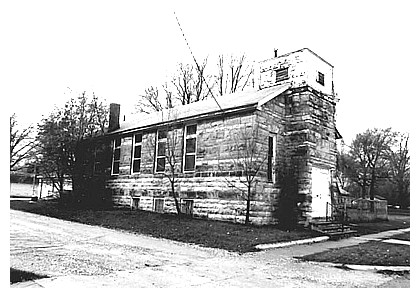
The Globe Gazette
[Section 8, Page 8] in 1936 the St. John' Baptist Church was built at 715 6th S. W. Eight years later in an impressive ceremony the congregation burned the mortgage, wiping out the last of a $10,000 debt.
The Globe Gazette
St. John Baptist Church, a tiny limestone structure at 715 Sixth St. S.W., is the only church owned and built by African-Americans in Mason City. "It was a cornerstone of the neighborhood," said Everet JEFFRIES of Newport News, Va. JEFFRIES grew up in St. John Church and the brickyard neighborhood in the 1940s and early 1950s. He and lifelong friend Sterling MACER of Springfield, Mo., are working to have the structure placed on the National Register of Historic Places. They hope the church can be refurbished and perhaps donated to the community. "It's in wonderful shape," JEFFRIES said.
In 1921, the church purchased the lot on Sixth Street Southwest and eventually built a basement structure where they could meet until the entire church was completed. The final structure was dedicated in September 1940. The Rev. J.M. EAVES was the minister. Vacant since about 1996, the structure still belongs to its members. Molly MYERS NAUMANN of Ottumwa, a historic preservation consultant, was called in the spring of 2000 to help place St. John Baptist on the National Register. She believes it is worthy because of its association with the black community in Mason City and its service to the diverse ethnic community. "I view it as a neighborhood gathering place," she said. MACER'S father was among the church members who helped build St. John in 1937, using limestone purchased for $600 from the Mason City School District. The stone was taken from the 1894 Grant School building, which had just been demolished. At the back of the church, a large stone saying "School" upside down is still plainly visible. "The church was my family," said MACER, who left Mason City in 1954. "My father died when I was 8 years old. My mother raised four boys. We all finished high school. We all went to college. I didn't get any scholarships. My relatives and the church were so supportive. That's the reason I made it." Lola (CHEATDOM) RHEM grew up attending St. John from 1930 to 1946. "It's never been a large congregation," she said. At the most, there were about 20-25 families, most of whom lived in the neighborhood. "Church was extremely important," RHEM said. "It kept the community together. It helped your sense of belonging. Our parents instilled a church attitude in my generation." St. John also held joint programs with other African-American churches in Mason City and Manly, including summer picnics in East Park and programs at Easter and Christmas. Its choir traveled around North Iowa. The church held frequent fund-raisers with fried chicken and sweet potato pie to pay off the mortgage. Albert POLACEK, who grew up during the 1930s on South Jackson Street, remembers when the church, then just a basement, was the site of free hot breakfasts for children at Grant School. A second African-American church, the Church of God and Christ, was also located in the brickyards neighborhood, on the west side of South Jackson Avenue, across from KIRCHOFF Grocery.
The Globe Gazette The St. John's Baptist congregation, formed in 1919, built a church at a cost of $5,000 with members doing much of the work. Dedication took place in August, 1940.
The Globe Gazette
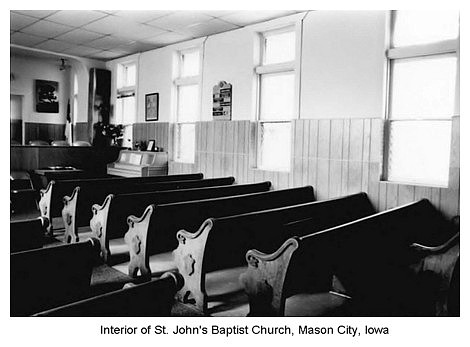 MASON CITY - The nomination of a Mason City church will be reviewed by the Mason City Historic Preservation Commission for inclusion on the National Register of Historic Places. Preservation Commission members are recommending St. John Baptist Church, 715 Sixth St. S.W., be placed on the register. The nomination will be presented to the City Council on Tuesday, Sept. 18. No formal action is required by the city council, said Beth ENRIGH, grant administrator for the Mason City Community Development Department. "As a certified local government, the city is supposed to have input into the nomination," ENRIGH said. "It also gives the city a chance to make corrections or to add information." Both groups will make recommendations to the state National Register Review Committee, which will consider the nomination Oct. 12. If approved by the state committee, the proposal will go before a national review committee which would have the final word on whether the church is placed on the Historic Register. The limestone structure, built from 1937-1940, is the only church owned and built by African Americans in Mason City. The structure appears much older than it is because it was built with limestone from the 1894 Grant School building, which had just been demolished. The congregation purchased the stones from the school district and church members hauled the large limestone block from the Grant School site. At the back of the church, chiseled into large stone and still visible are the upside down letters - Schoo. The windows are also original and were purchased from the old Grant School. St. John features a gable roof with square wooden bell tower centered above the front entrance. It is an example of simple vernacular design, based on a centuries-old rectangular nave floor plan, according to the nomination report. Sterling MACER of Springfield, Mo, and Everet JEFFRIES of Newport News, Va., sons of two of the original building committee members, have been working behind the scenes nearly three years to secure the listing on the National Register. "I'm terribly pleased to hear this and everyone I know of is in favor of that," MACER said Monday when learning of the nomination hearings. "When you consider our fathers and forefathers who came to a little town in North Iowa for work and ended up buying and building a church, its historical significance is considerable, especially for the time it was done and the status of black people in the community at the time." MACER said he hopes eventually the church can be refurbished and donated to the community to be put to some good use, not only for the neighborhood but for the entire community. Historic preservation consultant Molly MYERS NAUMANN of Ottumwa, who visited the church in the spring of 2000, recommended the building be placed on the National Register because of its association with the city's African American community and its service to a diverse ethnic community. "Members remember that the church was the focus of their life in the neighborhood," she writes, in her nomination to the state. The St. John congregation was organized in 1918. Meetings were first held in a rented labor hall and then in various homes. In 1921, the congregation purchased the lot on Sixth Street Southwest and dug a basement structure where it could meet until the entire church was completed. The 24-by-56-foot church was dedicated in September 1940. Vacant since 1996, the church still belongs to its members.
The Globe Gazette
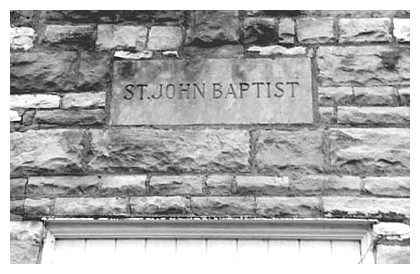 MASON CITY — St. John Baptist Church today stands solitary and quiet, a monument to the people who built it by hand 70 years ago. Completed in 1939 and closed in 1996, St. John Church was once the gathering place of the neighborhood. "It was home," said Willis HADDIX of Mason City. "Everybody met there. You went away and when you came back the first thing you want to do is go to St. John." Located at 715 Sixth St. S.W., the limestone church is listed on the National Register of Historic Places. The 24-by-56-foot structure is the only church in Mason City owned and built by African-Americans. "We want to fix it up and use it," said former member Everett JEFFRIES, 73, of Newport News, Va. "We want future generations to know that at one time there was a thriving all-black congregation here." Surviving church members, all of whom were children when St. John was built and who now live far from Mason City, are doing what they can to see that the church is restored and remembered. They've donated funds to help with the restoration and hope to acquire grant funding as well. They are working to form a St. John Baptist Historical Foundation. JEFFRIES's father, James Thomas JEFFRIES, was a member of the original building committee. Construction took three years because the builders did everything after they got off work, HADDIX said. "They did everything by hand," he said. Limestone from the 1894 Grant School building was purchased from the school district. Members hauled the stone several blocks in wheelbarrows, carts, wagons or whatever they had. SPENCER Brothers Cement Co. of Mason City, a black-owned company, did the cement work. HADDIX, whose uncle Lloyd BENNETT helped build the church, said he thinks it's important that neighborhood residents have a say in determining how the building will be used. Among the uses under consideration are a community center, reading room, day care or a museum about Mason City's African-American heritage. Kaye YOUNG of Mason City, who is helping facilitate the project, said the church has been inspected and is structurally sound. Thirteen pews, the altar, the ladder leading to the bell tower — all are still there. There are decorative bubble-glass windows, wood paneling and a pocket watch clock on the wall. Red carpet runs down the aisle. A portrait of Martin Luther KING Jr. can be seen on the wall of the minister's office. Above the altar and behind a red curtain, a depiction of a shepherd saving a lost sheep is hidden. It was hand-painted directly on the wall by a neighborhood resident, according to former church member Mary Alice LEWIS, 79, of Des Moines. "I'd like to have it used for anything they need to use it for," she said. "It has a history. You can’t destroy it."
The Globe Gazette
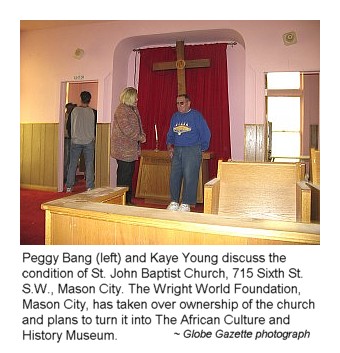 MASON CITY — Plans are in the works to turn St. John Baptist Church, 715 Sixth St. S.W., Mason City, into The African Culture and History Museum. The Wright World Foundation, Mason City, recently took over ownership of the church and completed a walk-through on Thursday. "There are a lot of stories," said Jameson BLACKMORE, executive vice president of the Wright World Foundation. "This was really at the center of the community." The limestone church was built by a group of African-Americans in 1939 and used for regular services until 1996. In 2002 it was added to the National Registry of Historic Places. A couple of years ago Kaye YOUNG, Mason City, approached the Wright World Foundation about doing something with the church. He had always been interested in restoring it. After plans to restore the YELLAND House in Mason City fell through BLACKMORE agreed to take on the project. "We're interested in the architecture because our foundation is architecture and environmental preservation," BLACKMORE said. "It's also the historic value and opportunity to try and do the project." Plans for the church include restoring and remodeling it and bringing it up to code, which will involve removing the addition on the west side and replacing it. The addition will include an elevator, staircase, restrooms and new entry/exit. All of the water and electrical systems will be replaced, too. Permanent and revolving displays will be exhibited in the sanctuary, and the altar converted into a stage for presentations and lectures. The basement will be divided into a library, offices and meeting rooms. A kitchen will also be built with access to the new addition, and a parking lot is planned west of the building. Pews and other items in the church such as the bell will be restored and used throughout the building. "I think it's a great project," said Leonard FOSTER, a consultant for the project. "My mother and grandmother used to go here." Former church member Willis HADDIX agreed that it's a great project. "I hope it gets going soon," he said. A timetable has not been set, however, BLACKMORE said, "The sooner the better." Completion will likely depend on fundraising. BLACKMORE is unsure how much the project will cost, but plans to pay for it through donations and grants. "Hopefully we can help out the neighborhood," he said, "because that's why it was here in the first place." For more information contact Blackmore at 641-423-7060 or wrightworldfoundation@mail.org. Transcriptions by Sharon R. Becker, May of 2011
The Globe Gazette
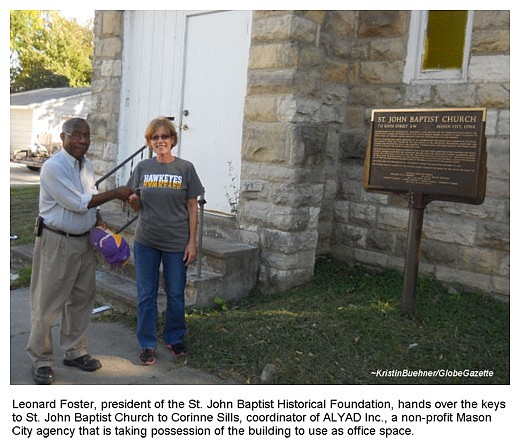 MASON CITY - St. John Baptist Church, built stone by stone by its members in 1939, will begin a new life as headquarters for a Mason City agency. Located at 715 Sixth St. S.W., the limestone church will house the office of ALYAD, Inc. -- a Mason City nonprofit organization that supplies foster families with the supplies they need to welcome new foster children into their homes. It was donated to ALYAD (Assisting Life to Youth with Adverse Demands) by the St. John Baptist Historical Foundation. "I'm excited to be a part of history and to be able to use a part of the building for our services to aid families and children in foster care," said Corinne Sills, ALYAD coordinator and founder. She took possession of the building after Mason City native Everett Jeffries of the St. John Baptist Historical Foundation gave her the keys. She contacted him when she heard the building might be available. Mason City resident Leonard Foster, president of the Historical Foundation, said plans are for Sills to renovate the main floor for use as an African-American museum. She is seeking donations and grants to help fund the renovation, which also includes the building's lower floor, where ALYAD will locate its office. A meeting is planned Wednesday, Oct. 9, between Sills and Foundation members Willis Haddix of Mason City, Jeffries of Newport News, Va., and Foster. They will discuss grant funding that might be available for the building renovation and prioritize projects that need to be done. Plans call for reshingling the roof, replacing the bell tower, replacing the furnace and water heater and restoring the back entrance. "We're going to need plumbing, electrical work and roofing," Sills said. "The structure is sound." The exterior of the historic church structure will be preserved. Former church members organized the St. John Baptist Historical Foundation in about 2009 to raise funds to restore the building, which is listed on the National Register of Historic Places. But fundraising efforts were stalled. Within a year, supporters of the restoration project were seeking a group that could use and care for the building in the years to come. "We've deeded the title to their organization," Foster said. "If they ever move, they'll deed it back to St. John's." He said the Historical Foundation is happy that someone will be using the building in a way that will benefit many people. The main floor of the church will remain a sanctuary, Sills said. Monthly meetings of the Iowa Foster Adoptive Parents Association will be held there. It is also hoped that breakfasts can some day be served to neighborhood children using the church kitchen, a function that St. John provided years ago. The ultimate goal is to make the church an African-American museum, where it will house such artifacts as the Bible used by the church's first pastor, the church piano, church pulpit, 13 pews and blue choir robes. On July 24, 70 students from the Northeast Iowa Christian Service Camp at Bristow removed old carpeting, a drop ceiling and a rotten back entrance. They also tore out old cupboards, the furnace, water heater and some walls on the lower level. Sills, a member of the Church of Christ, enlisted help from the camp, which is supported by the Church of Christ. Mason City ALYAD was formed in 2007. Its offices are currently located at Mohawk Square. Closed in 1996, St. John Baptist Church is the only church in Mason City owned and built by African-Americans. Limestone from the 1894 Grant School building was purchased by church members from the school district, hauled by wheelbarrows and wagons to the site of the present church and built.
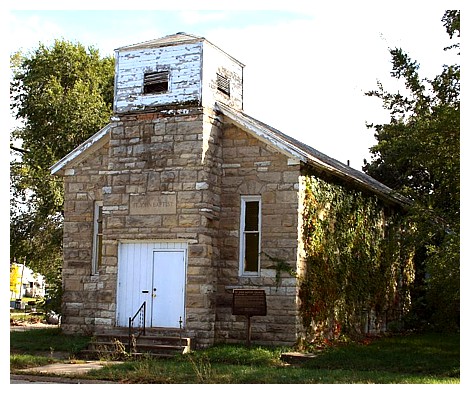 Transcription by Sharon R. Becker, November of 2013; updated December of 2014
|
Return to Cerro Gordo Church Index Page Return to Cerro Gordo's National Register of Historic Places Index Page Return to Cerro Gordo Home Page